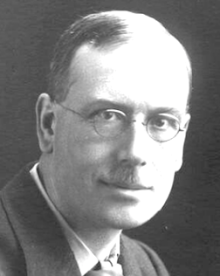
Michael Frank Wharlton Bunney was born in Venice, Italy in 1873 the son of the watercolourist John Wharlton Bunney (1828-1882). After studying at the Architectural Association Schools and the Royal Academy Schools in London, he was articled to Horace Field (1861-1948) in London from 1890 to c.1894. He then remained as Field's assistant until 1902 when he set up is own practice in London.
In 1905 he formed a partnership with Clifford Copeman Makins (1876-1963) in London as Bunney & Makins. They practised vtogether until at least the mid-1920s, during which time they designed some 90 houses in Hampstead Garden Suburb. During World War One Bunney was employed by the Ministry of Health Architects' Department for whom he designed housing and other buildings for munitions workers in Gretna, Dumfries, Scotland. In 1919 he was appointed Deputy Architect to the Ministry of Health, a position he held until 1922.
Bunney was elected an Associate of the Royal Institute of British Architects (ARIBA) in 1905 and a Fellow of the Royal Institute of British Architects (FRIBA) in 1919. With Horace Field he was co-author of English domestic architecture of the XVII and XVIII Centuries.
Bunney died in Hampstead, London 1927, or 1926. His death was registered in January 1927
_____
• Note: it is sometimes stated that Bunney was married to the architect Charlotte Gray (1910-1995) [later known as Charlotte Bunney]. This is incorrect. She was, in fact married his son, Michael John Hewetson Bunney (1907-1997). They married in 1935. Together they designed 13 Downshire Hill, a house for themselves in Hampstead in 1936. Michael Frank Wharlton Bunney married Edith Adelaide Hewetson in 1899.
With C. C. Makins, A.R.I.B.A.: — Chiefly domestic buildings In London and Home Counties, Hampstead and Gidea Park Garden Suburbs, Leicestershire, North Wales, Doncaster, Sussex and Westmorland; beach pavilion, Prestatyn, N. Wales;, 1912 town Shinning work at Gidea Park, Prestatyn, Southampton, Doncaster and elsewhere; factory at Hove, 1914. [Source: Who's Who in Architecture 1926]
Directory of British Architects 1834-1914. Compiled by Antonia Brodie, et al. Volume 1: A-K. London; New York: British Architectural Library, Royal Institute of British Architects/Continuum, 2001
Gray, A. Stuart. Edwardian architecture: a biographical dictionary. London: Gerald Duckworth & Co., Ltd., 1985
‘Obituary’. The Builder vol. 132, 11 February 1927 p. 237
‘Obituary’. Royal Institute of British Architects Journal vol. 34, 5 February 1927 p. 255
Who's Who in Architecture 1926. Edited by Frederick Chatterton. London: The Architectural Press, 1926